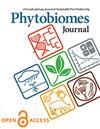N-cycling microbiome recruitment differences between modern and wild Zea mays
IF 2.6
3区 生物学
Q2 MICROBIOLOGY
引用次数: 4
Abstract
Rewilding modern agricultural cultivars by reintroducing beneficial ancestral traits is a proposed approach to improve sustainability of modern agricultural systems. In this study, we compared recruitment of the rhizosphere microbiome among modern inbred maize and wild teosinte to assess whether potentially beneficial plant microbiome traits have been lost through maize domestication and modern breeding. To do this, we surveyed the bacterial and fungal communities along with nitrogen cycling functional groups in the rhizosphere of 6 modern domesticated maize genotypes and ancestral wild teosinte genotypes, while controlling for environmental conditions and starting soil inoculum. Using a combination of high-throughput sequencing and quantitative PCR, we found that the rhizosphere microbiomes of modern inbred and wild teosinte differed substantially in taxonomic composition, species richness, and abundance of N-cycling functional genes. Furthermore, the modern vs wild designation explained 27% of the variation in the prokaryotic microbiome, 62% of the variation in N-cycling gene richness, and 66% of N-cycling gene abundance. Surprisingly, we found that modern inbred genotypes hosted microbial communities with higher taxonomic and functional gene diversity within their microbiomes compared to ancestral genotypes. These results imply that modern maize and wild maize differ in their interaction with N-cycling microorganisms in the rhizosphere and that genetic variation exists within Zea to potentially ‘rewild’ microbiome-associated traits (i.e., exudation, root phenotypes, etc.).现代玉米和野生玉米氮循环微生物组募集的差异
通过重新引入有益的祖先性状来培育现代农业品种是提高现代农业系统可持续性的一种建议方法。在这项研究中,我们比较了现代自交玉米和野生黄颡鱼根际微生物组的招募情况,以评估玉米驯化和现代育种是否失去了潜在的有益植物微生物组特征。为此,我们调查了6种现代驯化玉米基因型和祖先野生黄颡鱼基因型根际的细菌和真菌群落以及氮循环官能团,同时控制了环境条件和起始土壤接种。采用高通量测序和定量PCR相结合的方法,我们发现现代近交系和野生黄颡鱼的根际微生物组在分类组成、物种丰富度和氮循环功能基因丰度方面存在显著差异。此外,现代与野生名称解释了原核微生物组27%的变异、氮循环基因丰度62%的变异和氮循环基因丰富度66%的变异。令人惊讶的是,我们发现,与祖先基因型相比,现代近交系基因型的微生物群落具有更高的分类和功能基因多样性。这些结果表明,现代玉米和野生玉米在与根际氮循环微生物的相互作用方面存在差异,并且玉米体内存在遗传变异,有可能“重建”微生物组相关性状(即渗出、根系表型等)。
本文章由计算机程序翻译,如有差异,请以英文原文为准。
求助全文
约1分钟内获得全文
求助全文

 求助内容:
求助内容: 应助结果提醒方式:
应助结果提醒方式:


